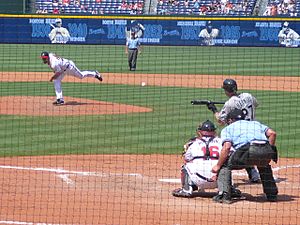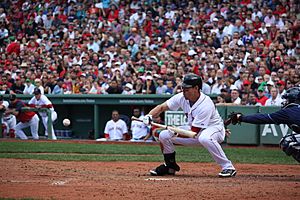Bunt (baseball) facts for kids
A bunt is a special way of hitting the ball in baseball or softball. Instead of swinging hard, the batter gently taps the ball. They hold the bat loosely in front of home plate and try to make the ball roll softly. The goal is to make it hard for the other team's infielders to catch the ball and get an out.
Contents
How to Bunt: The Technique
When a player bunts, they want the ball to roll into fair territory. They try to hit it far from the fielders but still inside the infield. This needs good hand-eye coordination and focus. The batter also needs to know where the other players are standing. They think about how the fielders might react and what kind of pitch the pitcher will throw.
To bunt, the batter usually turns their body towards the pitcher. They slide one hand up the bat to hold it steady. This move is called squaring up. A batter might square up before the pitcher throws the ball. Or they might do it as the ball gets close to home plate. Sometimes, a batter will square up, then quickly pull the bat back and take a full swing instead. This can surprise the fielders.
Different Kinds of Bunts
Sacrifice Bunt: Helping Runners Advance
A sacrifice bunt is when the batter bunts on purpose to help a baserunner move to the next base. The batter knows they will probably get out, but it's worth it to help a teammate. This type of bunt is often used to move a runner from first base to second base. It can also move a runner from second to third base, or even from third to home plate.
Sacrifice bunts are common in close games where not many runs are scored. Weaker hitters often use them, especially in games played in National League parks. A sacrifice bunt does not count as an at-bat for the batter. When doing a sacrifice bunt, the batter usually squares up early, well before the pitcher throws the ball.

A special type of sacrifice bunt is called a squeeze play. This happens when the batter bunts to score a runner from third base. In a suicide squeeze, the runner on third base starts running home as soon as the pitcher throws the ball. The batter absolutely must bunt the ball successfully. If they miss, the runner will likely be tagged out easily. This play is risky, so it's not used often, but it can be very exciting!
In a safer version, called the safety squeeze, the runner on third waits for the ball to be bunted. Only after the ball is hit do they run for home. If a runner scores on a squeeze play, the batter might get credit for a RBI.
Bunting for a Base Hit: Getting on Base
A batter can also bunt for a base hit. Here, the batter is trying to get on base themselves, not just advance a runner. This is not a sacrifice play. Even if a runner advances and the batter gets out, it's not a sacrifice bunt if the official scorer thinks the batter was trying to get a hit.
When bunting for a hit, the batter often waits until the pitcher starts throwing the ball before showing their bunt. This helps surprise the fielders. If it works, the bunt counts as a single hit. It's very rare for a bunt to be a double, triple, or home run.

Often, when trying to bunt for a hit, the batter starts running as they bunt the ball. This is called a drag bunt. Left-handed batters do this more often than right-handed batters. This is because their position in the batter's box is closer to first base. They don't have to run across home plate, where the ball is pitched, as they bunt.
Doing a drag bunt can make it harder to square up properly. Players might get one hand up the bat, or sometimes they bunt with both hands at the bottom of the bat. Some players, like Rafael Furcal, have even tried one-handed drag bunts!
Swinging Bunt: An Accidental Bunt
A swinging bunt happens when a batter tries to swing but hits the ball poorly. The ball rolls a short distance, like a bunt. This often happens after a checked swing. It looks like a bunt, but it's not a true bunt. If the scorer thinks the batter meant to swing, it won't count as a sacrifice. There's also a "slug" bunt, where the batter tries to hit the ball hard into the infield, surprising fielders who expect a soft bunt.
Fielding a Bunt: Making the Play
Catching and throwing a bunted ball can be harder than a regular hit. Bunted balls are usually slow, so fielders must charge (run quickly towards) the ball. They need to get to it fast to throw out the runner in time. Some well-placed bunts can be impossible to field, leading to a base hit.
When bunting for a hit, the goal is to hit the ball fast enough to get past the pitcher. But it also needs to be slow enough so other infielders don't have time to make a play. Bunting a ball into no-man's land can work well. This is the area between the pitcher, first baseman, and second baseman, or between the pitcher, catcher, and third baseman. Fielders might get confused about who should get the ball and who should cover first base. Sometimes, everyone tries to get the ball, and no one covers the base. Other times, no one goes for it, thinking someone else will.
Teams use a rotation play to defend against bunts. The first baseman runs to get the bunt. The second baseman then "rotates" from their usual spot to cover first base and catch the throw. The shortstop covers the base the runner is heading towards.
Special Bunt Rules
If a bunt goes foul and is not caught in the air, it always counts as a strike. This is true even if it's the third strike, which would normally mean a strikeout. This rule is different from other foul balls, which only count as a strike if they are not the third strike. This special rule only applies to true bunts, not to accidental bunt-like hits from a full swing. If a batter bunts the ball and their bat hits it again by accident, the ball is dead.
Also, the infield fly rule does not apply to bunts that pop up into the air. Instead, the intentional drop rule (Rule 6.05l), which also applies to line drives, can be used.


